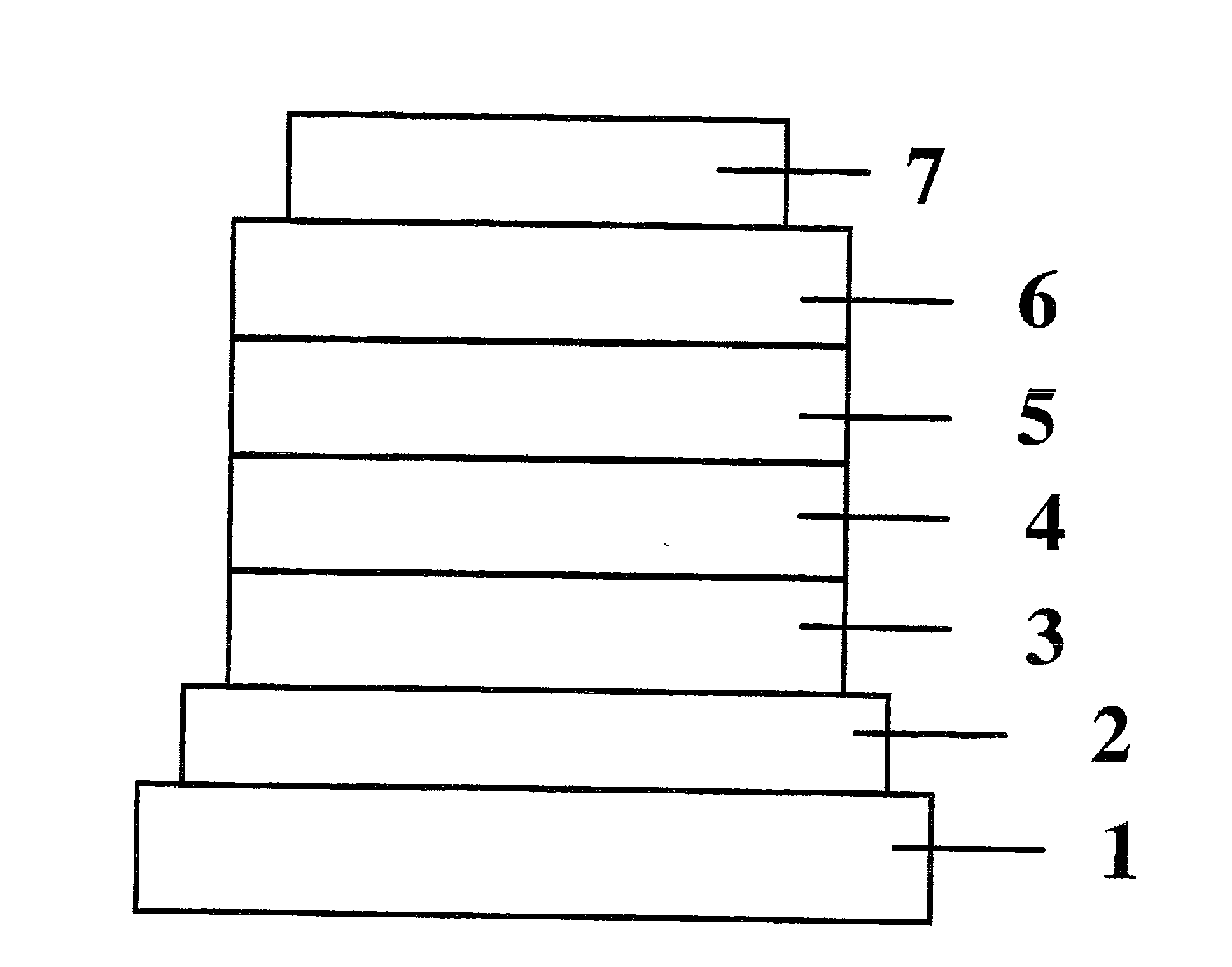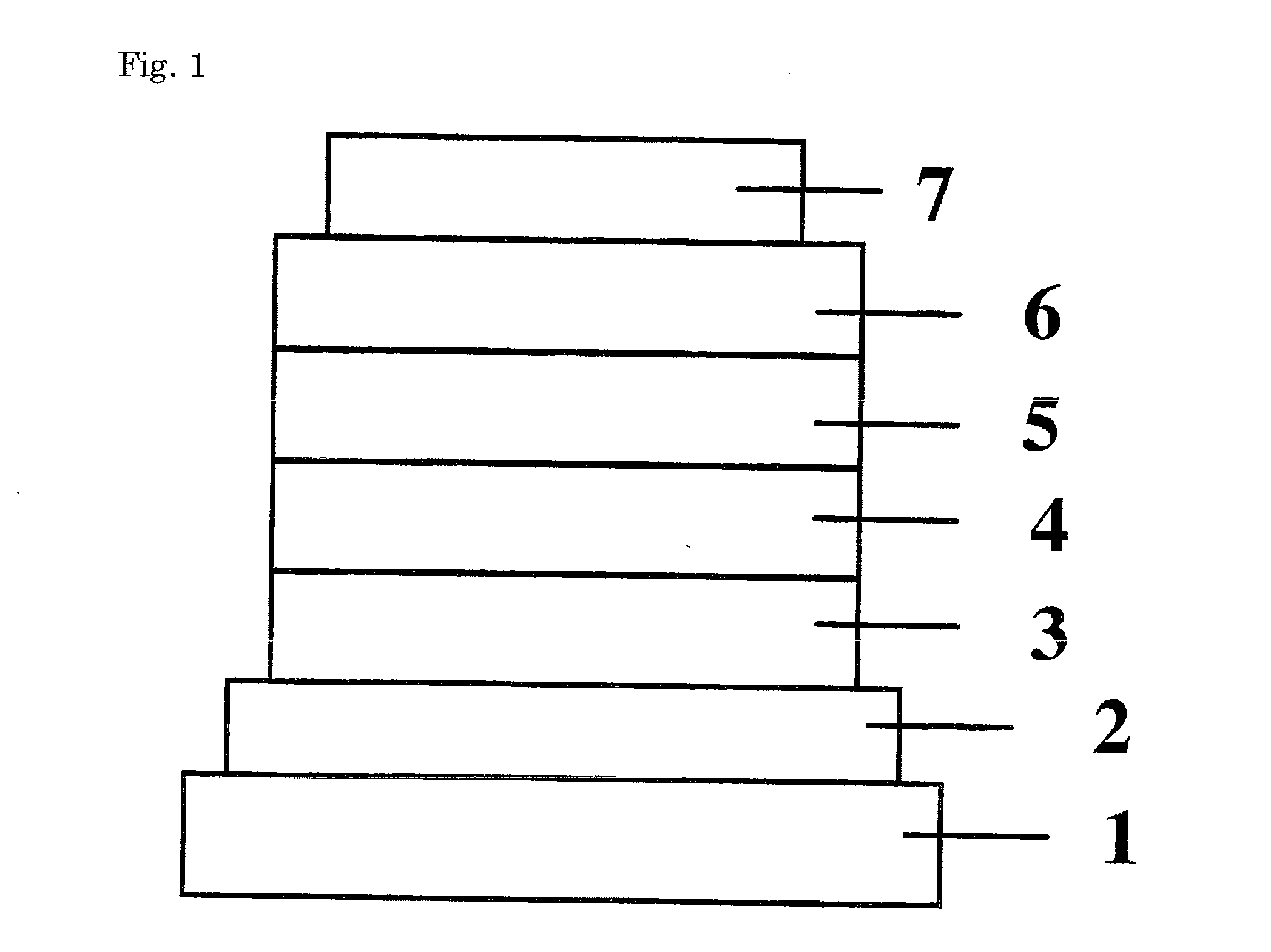Compound for organic electroluminescent device and organic electroluminescent device
a technology of electroluminescent devices and organic electroluminescent devices, which is applied in the direction of luminescent compositions, thermoelectric devices, organic chemistry, etc., can solve the problem that the proposed use of balq is not sufficient for practical use, and achieve the effect of improving the luminous efficiency of the device, high efficiency and ensuring the driving stability of the devi
- Summary
- Abstract
- Description
- Claims
- Application Information
AI Technical Summary
Benefits of technology
Problems solved by technology
Method used
Image
Examples
example 1
(Synthesis of Compound 21)
[0064]In a 200-ml three-necked flask that had been deaerated and filled with nitrogen were placed 33.3 g (0.297 mole) of 1,2-cyclohexanedione and 86.0 g (0.595 mole) of phenylhydrazine hydrochloride, then 1,000 ml of ethanol was added, and the mixture was stirred. Then, 3.0 g (0.03 mole) of concentrated sulfuric acid was added dropwise to the flask over 5 minutes. The mixture was then heated to 65° C. and stirred at this temperature for 4 hours. The mixture was cooled to room temperature, the violet brown crystals formed were collected by filtration, washed twice by reslurrying with 500 ml of ethanol, and dried under reduced pressure to give 80.0 g (0.286 mole, 96.3% yield) of a violet brown powder.
[0065]Then, 720 g of acetic acid and 72.0 g of trifluoroacetic acid were added to 72.0 g (0.258 mole) of the aforementioned violet brown powder and stirred. The mixture was then heated to 100° C. and stirred at this temperature for 15 hours. The mixture was coole...
example 2
[0070]Copper phthalocyanine (CuPC), α-NPD, and Alq3 were respectively used to form a hole-injecting layer, a hole-transporting layer, and an electron-transporting layer. They were deposited in thin films one upon another on a glass substrate having a 150 nm-thick ITO anode formed thereon by the vacuum deposition process at a degree of vacuum of 5.0×10−4 Pa. First, CuPC was deposited on the ITO anode to a thickness of 25 nm at a rate of 3.0 Å / sec as a hole-injecting layer. Then, α-NPD was deposited on the hole-injecting layer to a thickness of 55 nm at a rate of 3.0 Å / sec as a hole-transporting layer.
[0071]Then, Compound 21 and (Btp)2Iracac (Compound 41 illustrated in the specification) were co-deposited on the hole-transporting layer from different evaporation sources to a thickness of 47.5 nm as a light-emitting layer. The concentration of (Btp)2Iracac at this time was 8.0%.
[0072]Then, Alq3 was deposited to a thickness of 30 nm at a rate of 3.0 Å / sec as an electron-transporting lay...
example 3
(Synthesis of Compound 4)
[0073]In a 200-ml three-necked flask that had been deaerated and filled with nitrogen were placed 10.0 g (0.036 mole) of the white powder A obtained in Example 1, 12.9 g (0.093 mole) of potassium carbonate, 5.7 g (0.090 mole) of copper powder, and 50.0 g of tetraglyme and stirred under flow of nitrogen. To the flask was added dropwise a solution of 9.87 g (0.047 mole) of 2-bromonaphthalene in 10.0 g of tetraglyme over 10 minutes. After the dropwise addition, the mixture was stirred at 195° C. for 1 hour. The mixture was then cooled to room temperature and the insoluble matters were separated by filtration. To the filtrate were added 30 g of methanol and 150 g of water and the mixture was stirred for 2 hours. Thereafter, a precipitate was collected by filtration, washed twice by reslurrying with 100 g of water, then washed once by reslurrying with 100 g of methanol, dried under reduced pressure, and purified by column chromatography to give 13.0 g (0.034 mole...
PUM
| Property | Measurement | Unit |
|---|---|---|
| Tg | aaaaa | aaaaa |
| temperature | aaaaa | aaaaa |
| temperature | aaaaa | aaaaa |
Abstract
Description
Claims
Application Information
 Login to View More
Login to View More - R&D
- Intellectual Property
- Life Sciences
- Materials
- Tech Scout
- Unparalleled Data Quality
- Higher Quality Content
- 60% Fewer Hallucinations
Browse by: Latest US Patents, China's latest patents, Technical Efficacy Thesaurus, Application Domain, Technology Topic, Popular Technical Reports.
© 2025 PatSnap. All rights reserved.Legal|Privacy policy|Modern Slavery Act Transparency Statement|Sitemap|About US| Contact US: help@patsnap.com



